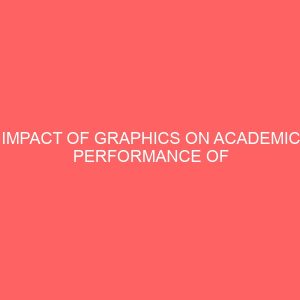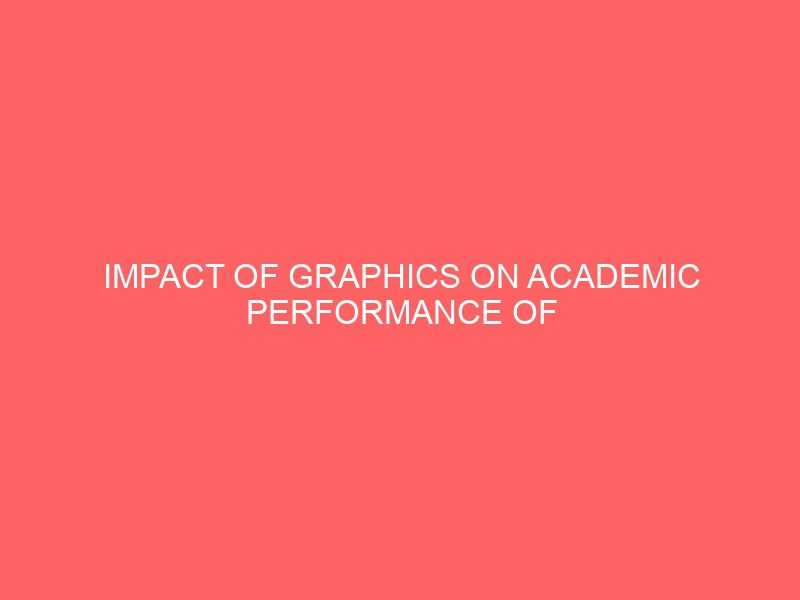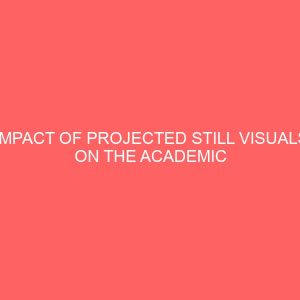Description
CHAPTER ONE
INTRODUCTION
1.1 Background to the study
This research is on Impact of graphics on academic performance of junior secondary school students in social studies in Jigawa state, Nigeria. The importance of education to the economic, and socio – political development of a multi – cultural country like Nigeria cannot be over-emphasized. The Social Studies curriculum is designed to enable students become responsible citizens and to lay a sound foundation for their subsequent study of related subjects such as Economics, History, Government, Geography, and Religious studies at higher levels of education (FRN, 2004). Dyel, 2011 observed that in spite of the various innovations introduced into the educational system, the attainment of the desired goals remain an illusion. This under-performance of students in Basic Social Studies is attributed to many factors such as; the constant use of the lecture method of teaching, the attitude of students and teachers towards the subject, difficulty in managing overcrowded classes due to rapid population growth and so on.
The use of the lecture method by teachers has been criticized by many researchers (Newby and Lai, 2008). This instructional method, according to them, is extremely didactic in approach, teacher-centered, and does not lead to meaningful learning. It can only encourage the development of passivity, docile learning and over-dependence on the teacher and on textbooks. Little effort is being made by teachers to supplement the oral instruction offered to learners with the integration of variety of graphic learning resources such as photographs, pictures, cartoons, to charts, maps, and diagrams.
Novak and Gowin (1984) observed that, the kind of strategies for teaching and learning which are capable of achieving the objectives of the school and society are those which emphasize on learners‟ creative skills and child centered Inquiry-based instruction. The graphics based teaching is proposed in this study in order to investigate its impact, is one of the activity-based teaching strategy in which students work as a team in small groups while they share ideas and experiences in the process. This could lead to improved academic performance of students in school (Roberson, 2012).
Again, the fact that students learn, remember, perform, and understand learning tasks in different ways (Cherry, 2012) pose a challenge the educational system that assumes everyone learn the same material in the same way through delivering lesson content via oral instruction alone (Lane, 2012). The incorporation of graphics in a lesson enable teachers to present a visual – spatial representation of learning materials; this combined with oral instruction can facilitate learning among greater number of students. Also engaging the learners in the actual production of graphic visuals offer to students the opportunities for hands – on experience, which is one of the best ways to learn.
Clark and Lyons, (2004) identified differences in learners‟ characteristics such as; age, sex, and social background among the factors that influence students‟ academic achievements. To this end graphic resources could be employed to remedy some of these disparities among learners via promoting effective content delivery across the various segments of students. The integration of this valuable teaching strategy is often a neglected skill among a greater number of Nigeria junior secondary school teachers.
It was against this background that it becomes imperative to conduct further study on the Impact of Graphics on Academic Performance of Junior Secondary School Students in Social Studies.
1.2 Statement of the Problems
The application of graphics to present learning contents to students in Nigerian primary and junior secondary schools has been a challenging task to most teachers. Problems associated to the utilization of graphic instructional resources could stem up from different aspects – ranging from teachers‟ attitude to work, dispositions of school managements to use of instructional media, and a multitude of other factors.
A reasonable percentage of the teachers at basic level Nigeria educational system are not abreast to new trends and developments in the field of education. As a result, most of them lack the required knowledge about the peculiarities of graphics and the conditions in which they provide best results in learning. This may be attributed to the scantiness of literatures on the subject, and shortfall in refresher courses / workshops for the teachers.
Inadequacy of skills on design of graphic resources among teachers is also another area of concern. After the decision to present a learning content in visual form has been reached by a teacher, the problem of basic illustration techniques arise. The difficulty in physically forming an image on paper becomes so frustrating to some teachers that they give up the idea and all the potentials of visual communication is lost. The deficiency of knowledge about the principles and elements of graphic design, a nervous hand, and a dripping pen often force many teachers into the avenue of escape. Except for the few who have the advantage of training in drawing or have access to art services, creating visual image is one of most challenging problems in teaching.
The use of appropriate criteria for selection and application of graphics to learning tasks is essential. Unfortunately this is another area where most teachers are lagging behind. This could be serious problem because no matter how good a graphic material is, it may not produce the desired impact unless it suits the learners‟ level of intelligence, prior knowledge, and learning styles. This is because while a particular graphic is helpful to some set of students, it could be distractive to others.
The lukewarm attitudes of some school managements towards providing necessary materials and encouragement to enable teachers improvise graphic visuals also deprives students from benefiting from the array of effective visual illustrations obtainable in textbooks and other printed sources. This ultimately undermines the academic achievements of students in junior secondary schools.
In view of the afore discussed problems, it becomes imperative to examine the impact of graphics on Academic Performance students in Social Studies at Junior Secondary School level to provide additional literature and empirical basis for teachers and school administrators to advance the cause of integrating graphics to teaching – learning process.
1.3 Objectives of the Study
The Objectives of the Study were as follows:
- Find out the impact of graphics in facilitating the academic performance of students in Social Studies.
- Determine the impact of graphics on the academic performance of rural and urban students in Social Studies.
- Investigate the impact of graphics on the academic performance of male and female students in Social Studies.
1.4 Research Questions
The following were questions that guided the study:
- What is the impact of graphics on facilitating students‟ academic performance in Social Studies?
- What is the impact of graphics on facilitating academic performance of rural and urban students in Social Studies?
- What is the impact of graphics on facilitating academic performance of male and female students in Social Studies?
1.5 Hypotheses
Based on the research questions the following null hypotheses were developed:
HO1: There is no significant difference in the mean scores of Social Studies students between those exposed to graphics and their counterparts exposed to lecture method.
HO2: There is no significant difference in mean scores of rural and urban students exposed to graphics in Social Studies.
HO3: There is no significant difference in the mean scores of male and female Social Studies students exposed to graphics.
1.6 Basic Assumptions
The study was based on the following basic assumptions:
- The effective use of graphics might promote effective teaching and learning.
- That a good graphic instructional medium might enables the teacher to communicate concepts to some learners more vividly than in just words.
- Graphics make the teaching- learning process student-centered thus enables the learners to recall lesson content better.
1.7 Significance of the Study
The findings of this research would be useful for the improvement of Nigerian Social Studies education in the following ways:
The study may serve as an insight to researchers, who might consult it in process of carrying out similar study in the future. Education students in colleges and universities may also find the study valuable when they consult it in the course of their studies. To school administrators, it will bring to the fore, the vital functions that graphics play in teaching-learning process especially as it relates to concretizing acquired knowledge and skills for long term memory.
Government may also find the study useful because it attempts to show areas where its intervention is required, such as greater commitment to issues like; re-training of teachers, provision of structures, and material resources/equipment that will promote effective teaching and learning. It is expected that government will further realize the potentialities of the various instructional materials as crucial tools to teachers for the attainment of instructional objectives and to that effect provide the needed financial and moral support to acquisition and proper utilization of such materials.
Curriculum planners and policy makers on education may also benefit from the study in such a way that when engaged in further review of curriculum, interest groups such as non-governmental organizations and students‟ associations will be contacted to make their inputs. It is hoped to be of significant value to social studies teachers who are implementers of the Social studies curriculum. The study may avail social studies teachers with an opportunity to broaden their professional skills in utilization of graphic instructional media in instruction. This would enhance their resourcefulness which will in turn impact behavioral changes in the learners – which is the ultimate goal of education.
To parents and non-governmental organizations, it could engage them to take more prime roles in the provision of instructional media to schools and creating opportunities for capacity building to keep teachers abreast to recent developments in the art of teaching. Finally, the study will provide additional literature that could enrich the existing ones in area of instructional graphics.
1.8 Scope of the Study
The study was limited to investigating the Impact of Graphics on Academic Performance of Junior Secondary School Students in Social Studies in Jigawa State, Nigeria. Junior Secondary School class one and three were not included in the study. It was also restricted to static graphics (hand-drawn / coloured representational pictures). The topic covered in the research was limited to „drug abuse‟ drawn from Nigeria Basic Social Studies pupils Book Two.








Reviews
There are no reviews yet.